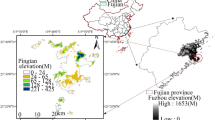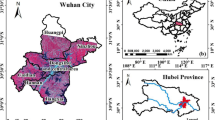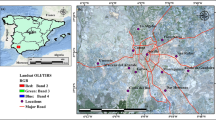Abstract
Land use/cover change is the main driving force of urban expansion which influences human–environment interactions. Generally, the formation of urban heat islands (UHIs) can be referred to as a negative “by-product” of urbanization. In the context of rapid urbanization, the present paper aims to capture the landscape changes and three patterns of urban expansion (i.e., infill, extension, and leapfrog), and provide a better understanding of the formation of the surface urban heat island (SUHI) in Dongguan, China, during the past 20+ years. Urban land increased from 28.87 × 103 ha in 1994 to 78.89 × 103 ha in 2005 and 101.05 × 103 ha in 2015, with a compound annual urban growth rate of 9.57% (1994–2005) and 2.51% (2005–2015), respectively. Based on the mean land surface temperature difference (Δ mean LST) between urban land (UL) and green space (GS), the SUHI intensity (SUHII) increased from 1.46 °C in 1994 to 2.32 °C in 2005 and 3.83 °C in 2015 in Dongguan. Overall, the Δ mean LST of urban areas increased from 2.61 °C (1994–2005) to 4.78 °C (2005–2015). The Δ mean LST between the city center and its surrounding areas decreased from 1994 to 2015, and the Δ mean LST between the city center and the suburbs gradually increased, primarily in 2015. In particular, both dense urban and the infill pattern of urban expansion had high mean LSTs in Dongguan, thus having negative impacts on sustainable urban development. The limited green space and open land should be strictly controlled or prohibited for transformation in urban areas. Particularly in dense regions, green roofs, green areas, and urban renewal actions could be considered for mitigating the urban heat island effect.






Similar content being viewed by others
References
Angel, S., Parent, J., & Civco, D. L. (2012). The fragmentation of urban landscapes: global evidence of a key attribute of the spatial structure of cities, 1990–2000. Environment and Urbanization, 24(1), 249–283.
Artis, D. A., & Carnahan, W. H. (1982). Survey of emissivity variability in thermography of urban areas. Remote Sensing of Environment, 12(4), 313–329.
Blaschke, T. (2010). Object based image analysis for remote sensing. ISPRS Journal of Photogrammetry and Remote Sensing, 65(1), 2–16.
Bokaie, M., Zarkesh, M. K., Arasteh, P. D., & Hosseini, A. (2016). Assessment of urban heat island based on the relationship between land surface temperature and land use/land cover in Tehran. Sustainable Cities and Society, 23, 94–104.
Carlson, T. N., & Ripley, D. A. (1997). On the relation between NDVI, fractional vegetation cover, and leaf area index. Remote Sensing of Environment, 62(3), 241–252.
Cetin, M. (2015). Using GIS analysis to assess urban green space in terms of accessibility: case study in Kutahya. International Journal of Sustainable Development & World Ecology, 22(5), 420–424.
Cetin, M., Adiguzel, F., Gungor, S., Kaya, E., & Sancar, M. C. (2019). Evaluation of thermal climatic region areas in terms of building density in urban management and planning for Burdur, Turkey. Air Quality, Atmosphere & Health, 12(9), 1103–1112.
Cetin, M. (2020). Climate comfort depending on different altitudes and land use in the urban areas in Kahramanmaras City. Air Quality, Atmosphere & Health, 13(8), 991–999.
Chen, J., Chang, K. T., Karacsonyi, D., & Zhang, X. (2014). Comparing urban land expansion and its driving factors in Shenzhen and Dongguan, China. Habitat International, 43, 61–71.
Chen, X., & Zhang, Y. (2017). Impacts of urban surface characteristics on spatiotemporal pattern of land surface temperature in Kunming of China. Sustainable Cities and Society, 32, 87–99.
Dai, C. G., Huang, X. B., & Dong, G. J. (2007). Support vector machine for classification of hyperspectral remote sensing imagery. In Fuzzy Systems and Knowledge Discovery, 2007. FSKD 2007. Fourth International Conference on (Vol. 4, pp. 77-80). IEEE.
Dietzel, C., Herold, M., Hemphill, J. J., & Clarke, K. C. (2005a). Spatio-temporal dynamics in California's Central Valley: empirical links to urban theory. International Journal of Geographical Information Science, 19(2), 175–195.
Dietzel, C., Oguz, H., Hemphill, J. J., Clarke, K. C., & Gazulis, N. (2005b). Diffusion and coalescence of the Houston Metropolitan Area: evidence supporting a new urban theory. Environment and Planning B: Planning and Design, 32(2), 231–246.
Dongguan Statistical Bureau (2016). Dongguan Statistical Yearbook 2016. Beijing: China Statistical Press.
Dutta, I., & Das, A. (2020). Exploring the spatio-temporal pattern of regional heat island (RHI) in an urban agglomeration of secondary cities in Eastern India. Urban Climate, 34, 100679.
Estoque, R. C., & Murayama, Y. (2015). Intensity and spatial pattern of urban land changes in the megacities of Southeast Asia. Land Use Policy, 48, 213–222.
Estoque, R. C., Murayama, Y., & Myint, S. W. (2017). Effects of landscape composition and pattern on land surface temperature: an urban heat island study in the megacities of Southeast Asia. Science of the Total Environment, 577, 349–359.
Estoque, R. C., & Murayama, Y. (2017). Monitoring surface urban heat island formation in a tropical mountain city using Landsat data (1987–2015). ISPRS Journal of Photogrammetry and Remote Sensing, 133, 18–29.
Fu, Z., Niu, S., & Dukes, J. S. (2015). What have we learned from global change manipulative experiments in China? A meta-analysis. Scientific Reports, 5, 12344.
Ghosh, A., Sharma, R., & Joshi, P. K. (2014). Random forest classification of urban landscape using Landsat archive and ancillary data: combining seasonal maps with decision level fusion. Applied Geography, 48, 31–41.
Hjort, J., Suomi, J., & Käyhkö, J. (2016). Extreme urban–rural temperatures in the coastal city of Turku, Finland: quantification and visualization based on a generalized additive model. Science of the Total Environment, 569, 507–517.
Kalisa, E., Fadlallah, S., Amani, M., Nahayo, L., & Habiyaremye, G. (2018). Temperature and air pollution relationship during heatwaves in Birmingham, UK. Sustainable Cities and Society, 43, 111–120.
Kalnay, E., & Cai, M. (2003). Impact of urbanization and land-use change on climate. Nature, 423(6939), 528–531.
Li, C., & Yin, J. (2013). A study on urban thermal field of Shanghai using multi-source remote sensing data. Journal of the Indian Society of Remote Sensing, 41(4), 1009–1019.
Li, L., Qian, J., Ou, C. Q., Zhou, Y. X., Guo, C., & Guo, Y. (2014). Spatial and temporal analysis of Air Pollution Index and its timescale-dependent relationship with meteorological factors in Guangzhou, China, 2001–2011. Environmental Pollution, 190, 75–81.
Liu, F., Zhang, X., Murayama, Y., & Morimoto, T. (2020). Impacts of land cover/use on the urban thermal environment: a comparative study of 10 megacities in China. Remote Sensing, 12(2), 307.
Liu, X., Li, X., Chen, Y., Tan, Z., Li, S., & Ai, B. (2010). A new landscape index for quantifying urban expansion using multi-temporal remotely sensed data. Landscape Ecology, 25(5), 671–682.
Lwin, K. K., & Murayama, Y. (2013). Evaluation of land cover classification based on multispectral versus pansharpened landsat ETM+ imagery. GIScience & Remote Sensing, 50(4), 458–472.
Martin-Vide, J., Sarricolea, P., & Moreno-García, M. C. (2015). On the definition of urban heat island intensity: the “rural” reference. Frontiers in Earth Science, 3, 24.
Mohan, M., Sati, A. P., & Bhati, S. (2020). Urban sprawl during five decadal period over National Capital Region of India: impact on urban heat island and thermal comfort. Urban Climate, 33, 100647.
Mountrakis, G., Im, J., & Ogole, C. (2011). Support vector machines in remote sensing: a review. ISPRS Journal of Photogrammetry and Remote Sensing, 66(3), 247–259.
Myint, S. W., Brazel, A., Okin, G., & Buyantuyev, A. (2010). Combined effects of impervious surface and vegetation cover on air temperature variations in a rapidly expanding desert city. GIScience & Remote Sensing, 47(3), 301–320.
Oke, T.R. (2006). Initial guidance to obtain representative meteorological observations at urban sites. IOM Report No.81, WMO/TD. No.1250, World Meteorological Organization, Geneva.
Pal, S., & Ziaul, S. K. (2017). Detection of land use and land cover change and land surface temperature in English Bazar urban centre. The Egyptian Journal of Remote Sensing and Space Science, 20(1), 125–145.
Parent, J, Urban Landscape Analysis Tool [Online]. Available: http://clear.uconn.edu/tools/ugat/index.htm. Accessed on 1-2-2021.
Pham, H. M., & Yamaguchi, Y. (2011). Urban growth and change analysis using remote sensing and spatial metrics from 1975 to 2003 for Hanoi, Vietnam. International Journal of Remote Sensing, 32(7), 1901–1915.
Pielke, R. A., Marland, G., Betts, R. A., Chase, T. N., Eastman, J. L., Niles, J. O., Niyogi, D., & Running, S. W. (2002). The influence of land-use change and landscape dynamics on the climate system: relevance to climate-change policy beyond the radiative effect of greenhouse gases. Philosophical Transactions of the Royal Society of London A: Mathematical, Physical and Engineering Sciences, 360, 1705–1719.
Ranagalage, M., Dissanayake, D., Murayama, Y., Zhang, X., Estoque, R. C., Perera, E., & Morimoto, T. (2018). Quantifying surface urban heat island formation in the world heritage tropical city of Sri Lanka. ISPRS International Journal of Geo-information, 7(9), 341.
Ren, G. Y. (2015). Urbanization as a major driver of urban climate change. Advances in Climate Change Research, 6(1), 1–6.
Sahana, M., Hong, H., & Sajjad, H. (2018). Analyzing urban spatial patterns and trend of urban growth using urban sprawl matrix: a study on Kolkata urban agglomeration, India. Science of the Total Environment, 628-629, 1557–1566.
Sharma, R., & Joshi, P. K. (2013). Monitoring urban landscape dynamics over Delhi (India) using remote sensing (1998–2011) inputs. Journal of the Indian Society of Remote Sensing, 41(3), 641–650.
Shen, H., Huang, L., Zhang, L., Wu, P., & Zeng, C. (2016). Long-term and fine-scale satellite monitoring of the urban heat island effect by the fusion of multi-temporal and multi-sensor remote sensed data: A 26-year case study of the city of Wuhan in China. Remote Sensing of Environment, 172, 109–125.
Shi, L., Kloog, I., Zanobetti, A., Liu, P., & Schwartz, J. D. (2015). Impacts of temperature and its variability on mortality in New England. Nature Climate Change, 5(11), 988–991.
Simwanda, M., Ranagalage, M., Estoque, R. C., & Murayama, Y. (2019). Spatial analysis of surface urban heat islands in four rapidly growing African Cities. Remote Sensing, 11(14), 1645.
Stewart, I., & Oke, T. (2009). Classifying urban climate field sites by local climate zones: the case of Nagano, Japan. In: The Seventh International Conference on Urban Climate, 9 June–3 July 2009, Yokohama, Japan.
Sobrino, J. A., Jimenez-Munoz, J. C., & Paolini, L. (2004). Land surface temperature retrieval from LANDSAT TM 5. Remote Sensing of Environment, 90(4), 434–440.
Song, J., Du, S., Feng, X., & Guo, L. (2014). The relationships between landscape compositions and land surface temperature: quantifying their resolution sensitivity with spatial regression models. Landscape and Urban Planning, 123, 145–157.
Subasinghe, S., & Murayama, Y. (2017). Urban growth evaluation: a new approach using neighborhood characteristics of remotely sensed land use data. In Spatial Data Handling in Big Data Era. Singapore: Springer.
Sultana, S., & Satyanarayana, A. N. V. (2020). Assessment of urbanisation and urban heat island intensities using landsat imageries during 2000–2018 over a sub-tropical Indian City. Sustainable Cities and Society, 52, 101846.
Sun, C., Wu, Z. F., Lv, Z. Q., Yao, N., & Wei, J. B. (2013). Quantifying different types of urban growth and the change dynamic in Guangzhou using multi-temporal remote sensing data. International Journal of Applied Earth Observation and Geoinformation, 21, 409–417.
Sun, Q., Wu, Z., & Tan, J. (2012). The relationship between land surface temperature and land use/land cover in Guangzhou, China. Environmental Earth Sciences, 65(6), 1687–1694.
Sun, Y., Zhang, X., Ren, G., Zwiers, F. W., & Hu, T. (2016). Contribution of urbanization to warming in China. Nature Climate Change, 6(7), 706.
Sun, J., Li, Y. P., Gao, P. P., Suo, C., & Xia, B. C. (2018). Analyzing urban ecosystem variation in the City of Dongguan: a stepwise cluster modeling approach. Environmental Research, 166, 276–289.
Taheri Shahraiyni, H., Sodoudi, S., El-Zafarany, A., Abou El Seoud, T., Ashraf, H., & Krone, K. (2016). A comprehensive statistical study on daytime surface urban heat island during summer in urban areas, case study: Cairo and its new towns. Remote Sensing, 8(8), 643.
Tran, D. X., Pla, F., Latorre-Carmona, P., Myint, S. W., Caetano, M., & Kieu, H. V. (2017). Characterizing the relationship between land use land cover change and land surface temperature. ISPRS Journal of Photogrammetry and Remote Sensing, 124, 119–132.
Ünal, Y. S., Sonuç, C. Y., Incecik, S., Topcu, H. S., Diren-Üstün, D. H., & Temizöz, H. P. (2019). Investigating urban heat island intensity in Istanbul. Theoretical and Applied Climatology, 139(1-2), 175–190.
Wang, Y., Wang, A., Zhai, J., Tao, H., Jiang, T., Su, B., Yang, J., Wang, G., Liu, Q., Gao, C., Kundzewicz, Z. W., Zhan, M., Feng, Z., & Fischer, T. (2019). Tens of thousands additional deaths annually in cities of China between 1.5 C and 2.0 C warming. Nature Communications, 10(1), 1–7.
Weber, N., Haase, D., & Franck, U. (2014). Zooming into temperature conditions in the city of Leipzig: how do urban built and green structures influence earth surface temperatures in the city? Science of the Total Environment, 496, 289–298.
Wei, C., Taubenböck, H., & Blaschke, T. (2017). Measuring urban agglomeration using a city-scale dasymetric population map: a study in the Pearl River Delta, China. Habitat International, 59, 32–43.
Weng, Q., Lu, D., & Schubring, J. (2004). Estimation of land surface temperature–vegetation abundance relationship for urban heat island studies. Remote Sensing of Environment, 89(4), 467–483.
Wilson, E. H., Hurd, J. D., Civco, D. L., Prisloe, M. P., & Arnold, C. (2003). Development of a geospatial model to quantify, describe and map urban growth. Remote Sensing of Environment, 86(3), 275–285.
Xu, C., Liu, M., Zhang, C., An, S., Yu, W., & Chen, J. M. (2007). The spatiotemporal dynamics of rapid urban growth in the Nanjing metropolitan region of China. Landscape Ecology, 22(6), 925–937.
Xu, M., He, C., Liu, Z., & Dou, Y. (2016). How did urban land expand in China between 1992 and 2015? A multi-scale landscape analysis. PLoS ONE, 11(5), e0154839.
Yao, R., Wang, L., Huang, X., Gong, W., & Xia, X. (2019). Greening in rural areas increases the surface urban heat island intensity. Geophysical Research Letters, 46(4), 2204–2212.
Yin, Y., Ma, D., & Wu, S. (2018). Climate change risk to forests in China associated with warming. Scientific Reports, 8(1), 1–13.
Zhang, H., Qi, Z. F., Ye, X. Y., Cai, Y. B., Ma, W. C., & Chen, M. N. (2013). Analysis of land use/land cover change, population shift, and their effects on spatiotemporal patterns of urban heat islands in metropolitan Shanghai, China. Applied Geography, 44, 121–133.
Zhang, H., Huang, M., Qing, X., Li, G., & Tian, C. (2017a). Bibliometric analysis of global remote sensing research during 2010–2015. ISPRS International Journal of Geo-Information, 6(11), 332.
Zhang, X., Estoque, R. C., & Murayama, Y. (2017b). An urban heat island study in Nanchang City, China based on land surface temperature and social-ecological variables. Sustainable Cities and Society, 32, 557–568.
Zhou, D., Zhao, S., Zhang, L., Sun, G., & Liu, Y. (2015). The footprint of urban heat island effect in China. Scientific Reports, 5, 11160.
Acknowledgments
This research was funded by the Japan Society for the Promotion of Science (JSPS) Grant-in-Aid for Scientific Research (A) 16H01830 and Scientific Research (B) 18H00763.
Author information
Authors and Affiliations
Corresponding author
Additional information
Publisher’s note
Springer Nature remains neutral with regard to jurisdictional claims in published maps and institutional affiliations.
Rights and permissions
About this article
Cite this article
Zhang, X., Estoque, R.C., Murayama, Y. et al. Capturing urban heat island formation in a subtropical city of China based on Landsat images: implications for sustainable urban development. Environ Monit Assess 193, 130 (2021). https://doi.org/10.1007/s10661-021-08890-w
Received:
Accepted:
Published:
DOI: https://doi.org/10.1007/s10661-021-08890-w




